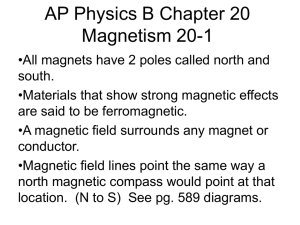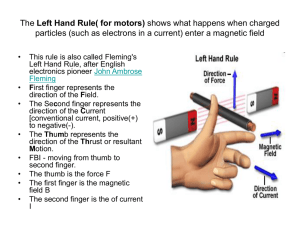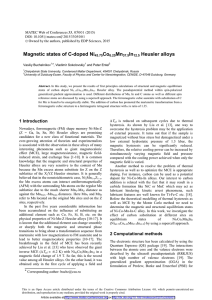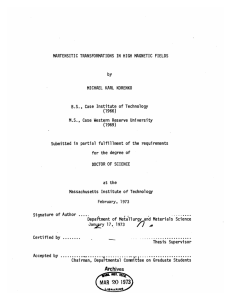Ni 49 Mn 29 Ga 22
advertisement
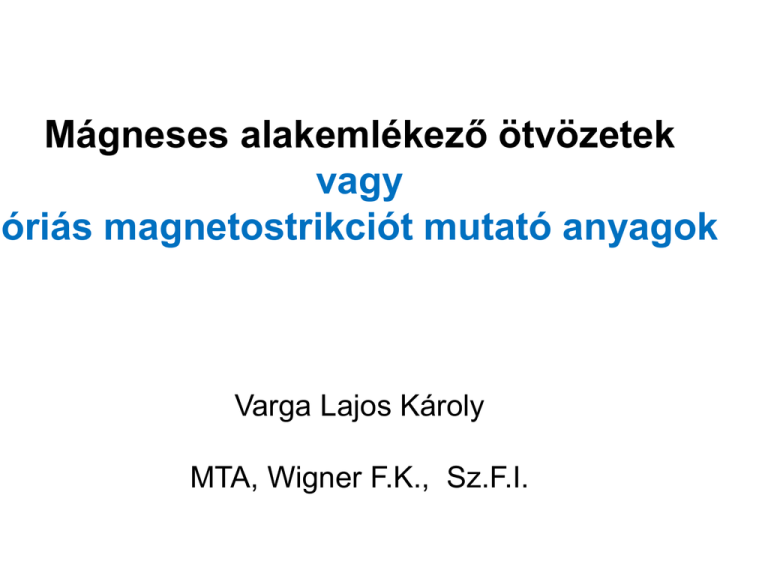
Mágneses alakemlékező ötvözetek vagy óriás magnetostrikciót mutató anyagok Varga Lajos Károly MTA, Wigner F.K., Sz.F.I. What is SMART material? Material that changes the coefficient of one SHAPE of its properties in response to an external H field SHAPE stimulus and when this change can be used to control the stimulus. Active Materials-Definition-coupling Pb-Mg-Nb Tb-Fe-Dy Fe 8 ppm = 8x10-4 % Ni 40 ppm = 4x10-3 % Terfenol 2000 ppm =0.2 % Elasztikus határ 0.1-0.2 % FSMA : 10 % F e 0 .7 2 5 G a 0 .2 7 5 l / l (p p m ) 120 90 60 AS CAST 150 K 280 K 30 o o H T : 1 1 0 0 C /1 h + 8 7 5 C /1 h 150 K 280 K 0 0 1 2 3 H (T ) 0 4 5 Összehasonlító táblázata a különböző aktív anyagoknak A basic actuator structure A basic actuator consists of a coil and a MSM element. Actuator An actuator produced by AdaptaMat which controls pressure in a pneumatic valve. When magnetic field is applied, the MSM element elongates in the direction perpendicular to the magnetic field. MAGNETICALLY CONTROLLED ACTUATORS BASED ON Ni-Mn-Ga (ADAPTAMAT) A5-2 A06-3 Displacement 0,6 – 5 mm, Force – up to 1000 Newtons, Frequency 300 – 1000 Hz A1-2000 Strain can be reduced by introducing twins • • Deformation may take different direction in different regions of the sample. These structural domains have well defined boundaries (twin boundary) and are called variants. Shape Memory Alloy A material, previously deformed in MARTENSITE (the low temperature) phaserecovers its original shape, when heated up to the austenite-the high temperature phase. The martensitic transformation occurs across a given range of temperature (Ms to Mf, from austenite to martensite and As to Af, from martensite to austenite) Fe43.5Mn34Al15Ni7.5. Magnetic Shape Memory Effect Ferromagnetic shape memory alloys (FSMA) are smart materials possessing not only ferromagnetic as well as thermal shape memory properties but also large magnetic field induced strains. In single crystalline Ni2MnGa bulk material, strains as large Principle of magnetic field induced reas 10% have been realized. orientation of martensitic variants. Requirements for FSM Effect The material should be ferromagnetic and exhibit martensitic transformation, thus TM→A< TC The magnetic anisotropy energy should be greater than the energy needed to move the twin boundary. • Till now, numerous FSMA systems have been investigated e.g. Ni-Co-Al, Co-Nb-Sn, Ni-Mn-Ge and Ni2MnAl Magnetic domains and twin bands Topography image MFM image Magnetic force microscopy image of Ni2.23Mn0.8Ga in the martensitic phase at room temperature clearly shows the twin bands (width 10 micron) and magnetic domains (width 2-3 microns) C. Biswas, S. Banik, A. K. Shukla, R. S. Dhaka, V. Ganesan, and S. R. Barman, , Surface Science, 600, 3749 (2006). Progress in FSMA • The work on FSMA started in 1996 when both ferromagnetism and shape memory effect were observed in Ni-Mn-Ga alloy by K.Ullako in R.C. O’Handley’s group . • In 1999, 0.3% strain was reported by Wu et. al., 1.3% by Tickle et al., 4 % by James et al., 4.3 % by Tickle et al. • In 2000, 5 % and 5.1% reported by Heckzo et.al , 5.7 % by Murray et. al. • Later, Murray et al. reported 6.2% strain and Srivastava et al. reached 5.9% strain at composition around Ni50Mn28Ga22 and Ni49Mn29Ga22 respectively almost reaching the theoretical maximum. • A .Sozinov et. al. obtained a maximum strain of 9.5% in Ni50Mn30Ga20. Till now this is the maximum strain obtained in related crystal. Since then lot of work has been done on this alloy. Ni2MnGa is a Heusler alloy L21 structure: Four interpenetrating f.c.c. sublattices with : Ni at (1/4,1/4,1/4 ) and (3/4,3/4,3/4) Mn at (1/2,1/2,1/2), Ga at (0,0,0). Ferromagnetism due to RKKY indirect exchange interaction. Heusler alloys are famous for localized large magnetic moments on Mn. Crystal structure at room temperature M a r t e n s i A u s t e n i t e t e Mn Ga Ga Mn Ga Mn Ga Mn Ga Mn Ga Ga Mn Ni N i1 Ni Ga N i1 Ni Ni N i1 Ga Mn N i1 Mn Ga Mn Ga Mn Ga Mn Ga Mn Mn Ga N i1 Ni N i1 Mn Ni Ni Ga Ni N i1 N i1 Mn Ga Mn Ga Ga Mn Mn Ga Ga Mn Ga Mn Cubic P o wd erC ell 1 . 0 Ga Tetragonal Martensitic phase at room temperature. P o wd erC ell 1 . 0 DSC and ac-susceptibility of Ni2+xMn1−xGa x= 0 x Ms (TM) Mf As Af 0 205 189 216 234 0.2 4 434 408 423 447 0.3 5 537 523 553 582 x= 0.24 x= 0.35 DSC: [Rate 10 C/min] Susceptibility: [ 26 Oe field, 33.33 Hz] Albertini et al, JAP, 89 5614, 2001 Small width of hysteresis 14-38 K for x=0; highly thermoelastic (mobile interface, strain less). Decrease of c at TM due to large magnetocrystalline anisotropy in martensitic phase. For x>0.2 TM>TC: change in c shape. Banik, Chakrabarti, Kumar, Mukhopadhyay, Awasthi, Ranjan, Schneider, Ahuja, and Barman, PRB, 74, 085110 (2006) Ni-Mn-Ga is ferromagnetic, and exhibits magnetic SMA SMA: Transformation from the martensite to austenite phase temperature or stress. by FSMA: Entirely within the martensite phase, actuation by magnetic field, faster than conventional stress or temperature induced SMA. 10% Magnetic Field Induced Strain in Ni50Mn30Ga20 reported. The magnetic moments without the external field The rotation of the magnetic moments within the twins. The redistribution of the twin variants. Phase coexistence in Ni2MnGa (a) Hysteresis curve showing mole fraction of the cubic phase determined from Rietveld analysis of the XRD patterns. (b) Ac-susceptibity; Decrease at TM due to large magnetocrystalline anisotropy in martensitic phase. (c) Differential scanning calorimetry Nice agreement between structural, magnetic and thermal techniques. Small width of hysteresis 14-38 K; highly thermoelastic (mobile interface, strain less). Resistivity and magnetoresistance Metallic behaviour with a clear jump at TM. • Highest known magnetoresistance at room temperature for shape memory alloys. For x=0.35, MR is around 7.3% at 8T. • Experimental MR behavior agrees with the theoretical calculation. C. Biswas, R. Rawat, S.R. Barman, Appl. Phys. Lett., 86, 202508 (2005) Smart actuator materials Potential fields of applications Ni45Co5Mn40Sn10. The low temperature phase is nonmagnetic but the high temperature phase is a strong magnet, almost as strong as iron at the same temperature." The researchers immediately realized that such an alloy could act like the phase-transitioning water in a power plant. If you surround the alloy by a small coil and heat it through the phase transformation, the suddenly changing magnetization induces a current in the coil," said James. "In the process the alloy absorbs some latent heat. It turns heat directly into electricity." Hysteresis and unusual magnetic properties in the singular Heusler alloy Ni45Co5Mn40Sn10 Vijay Srivastava, Xian Chen and Richard D. James Applied Physics Letters, 97, 2010. A mi csoportunk hozzájárulása a „Ferromágneses emlékező ötvözetek” témájához: Együttműködve a Delhi Egyetemmel: Appl. Phys. Lett. 97, 122505 (2010) Ni-Mn-Ga J. Appl. Phys, 109, 083915 (2011) Ni-Mn-Al We have worked on the following aspects: Single Crystal • Evidence of intermartensitic phase in single crystal Ni-Mn-Ga- magnetically & electrically verified • Observation of three martensitic phases in Ni-Mn-Ga single crystal- in magnetic measurements • • Effect of twin boundaries on electrical properties Crystal structure identification of different martensite phases by low temperature Xray diffraction Bulk Polycrystals • Series Ni53+XMn25-XAl22 (X=0,±1,±2) prepared and detailed Structural property studies of the alloys prepared by different heat treatment • Magnetic properties of the Aged Sample • Magnetic and electrical properties of annealed samples followed by equilibrium cooled XRD of NiMnGa single crystal Cubic Ausenite Tetrag’l Martensite Ni49Mn29Ga22 400 N iM n G a q = 1 0 K m in -1 DTA N iM nG a q = 2 0 K m in co o ling 200 T c = 1 0 1 °C 100 he a ting TM AG In te n s itie s / a rb . u . In te n s itie s / a rb . u . 300 -1 Tc DTA TM AG 0 0 70 60 80 T e m p e ra tu re / °C 100 T e m p e ra tu re / °C M-A and A-M transition with hysteresis of about 5 K Curie transition is free from hysteresis and was recorded at around 100°C. 100 Ni49Mn29Ga22 DSC DAW 108 T A = 6 8 .2 °C 1 .2 N iM n G a 0 .8 m = 5 .9 m g h e a tin g q [K / m in ] 20 10 T / K 0 .4 4 2 0 .0 2 4 -0 .4 10 20 -0 .8 c o o lin g -1 .2 T M = 6 2 .6 °C 55 60 65 70 75 T e m p e ra tu re / °C Phase transition temperatures for heating and cooling with rates between 20 and 2 Kmin-1 Ni49Mn29Ga22 D S C N iM n G a q = 1 0 K m in -1 T / K M2 M3 0 .2 bis tabile s table 0 .1 tris table bis tabile M1 s table A bis tabile 0 .3 s table heating 0 .0 M3 M3 -0 .1 M3 c ooling endo M2 M2 M1 -0 .2 M1 A A 140 160 180 200 220 240 260 280 300 320 340 360 T e m p e ra tu re / K • Enthalpy of allotropic transformation is ~ 0.25 kJ/mol ~ same magnitude or even lower than the energy stored by cold working (Houska et al, Acta. Metall.18, 81, 1960) • Assume a Molecular weight ~ 50g, density ~ 8g/cc 0.25 kJ/mol ~ 250J/50g = 5J/g martensite- austenite transformation • On the other hand magnetocrystalline energy ~ 106 J/m3 = 106 J/ 106cm3 /8g/cm3 = 1/8 J /g • Zeeman energy : 1T*5000*80 A/m = 40*104J/m3 = 40*104J/106cm3/8g/cm3 =5*10-2J/g Nickle Managnese&Aluminium of 99.99% purity Pellets Of Ni53-xMn25+xAl22 Vacuum (2 X 10-5) annealed, 10000C for 72 hours Quenched in ice water ,Some samples are taken out for characterization Some samples are aged in vacuum (2 X10-5 Torr), 4000C for 450 hours c vs. T of the Series 0.0016 51 52 53 54 55 0.0014 Chi (M/H) 0.0012 0.0010 0.0008 TC 0.0006 0.0004 0.0002 0.0000 0 50 100 150 200 Temp (K) 250 300 Electronic and structural transitions in Ni52Mn26Al22 polycrystalline alloy B -4 5.50x10 -4 4.75x10 -4 -4 4.5x10 -4 ZFC 0.00040 4.0x10 -4 3.5x10 -4 50 100 150 200 250 300 Temp(K) Cooling Curve -4 4.00x10 -4 3.75x10 FC 0.0007 0.00045 -4 5.0x10 3.0x10 4.50x10 -4 5.5x10 c (emu/g-Oe) Resistivity (cm) -4 5.00x10 Chi -4 c(emu/g-Oe) -4 Resistance ( ) Heating Curve 5.25x10 4.25x10 Chi -4 6.0x10 0.00035 0.0006 0.0005 0.0004 ZFC 0.0003 0.0002 0 0.00030 50 100 150 200 250 300 Temp (K) FC 0.00025 -4 3.50x10 0.00020 180 200 220 240 260 280 300 Temp (K) 200 220 240 260 280 Temp (K) Property As Af Ms Mf Electrical 210 250 245 200 Magnetic 214 260 255 210 Structural 215 250 240 200 Comparison of the enthalpy and boundary friction energy obtained in the present case with the previous reports Alloys ∆T (K) T0 (K) ∆H J/mol ∆S J/mol.K Fr J/mol Cu29%Zn3%Ala 10 254 -416.2 -1.42 21.21 Cu14%Al2.5%Nib 10 303 -515.0 -1.70 19 Ni52Mn23Ga25c 6 311 -1617.2 -5.20 12.76 Ni52Mn26Al22d 35 247 -6748.46 -27.54 98 a Y. Deng and G. S. Ansell, Acta Metall. Mater. 38, 69 (1990) bR. J. Salzbrenner and M. Cohen, Acta Matall. 27, 739 (1979) c Wong et al. Phys. Rev. B (2001) d The present work



